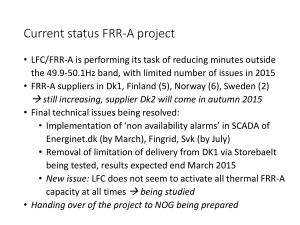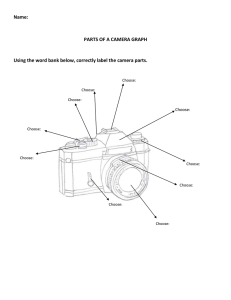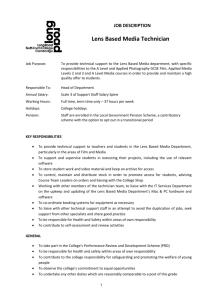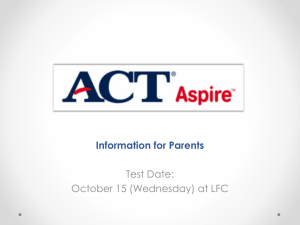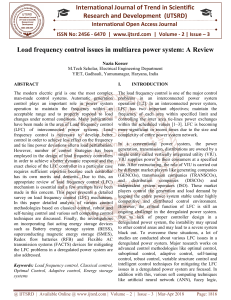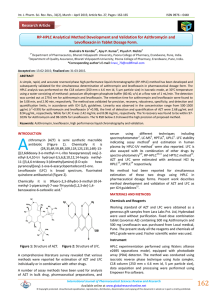14th CONGRESS OF THE HAMBURG 1980
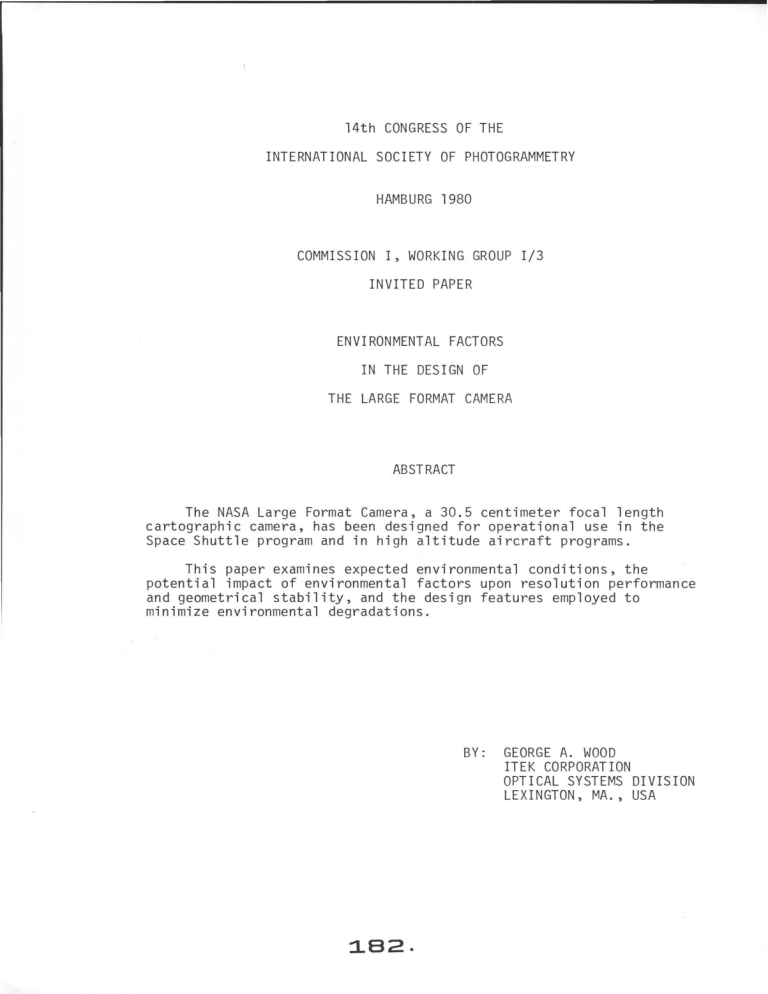
14th CONGRESS OF THE
INTERNATIONAL SOCIETY OF PHOTOGRAMMETRY
HAMBURG 1980
COMMISSION I, WORKING GROUP I/3
INVITED PAPER
ENVIRONMENTAL FACTORS
IN THE DESIGN OF
THE LARGE FORMAT CAMERA
ABSTRACT
The NASA Large Format Camera, a 30.5 centimeter focal length cartographic camera, has been designed for operational use in the
SpaceShuttle program and in high altitude aircraft programs.
This paper examines expected environmental conditions, the potential impact of environmental factors upon resolution performance and geometrical stability, and the design features employed to minimize environmental degradations.
BY: GEORGE A. WOOD
ITEK CORPORATION
OPTICAL SYSTEMS DIVISION
LEXINGTON, MA., USA
:1.82.
ENVIRONMENTAL FACTORS IN THE
DESIGN OF THE LARGE FORMAT CAMERA
IN}RODUCTION
The National Aeronautics and Space Administration (NASA) of the
United States has acquired a Large Format Camera (LFC) for use on the
Space Transportation System (STS) Orbiter in order to acquire cartographic quality photography of the Earth, from space. It is the objective of this paper to discuss briefly the features of LFC design which are directly related to the factors which are associated with its operational environment.
Not incidental to environmental design is the fact that the LFC must also operate at full performance potential when deployed in a high performance jet aircraft rather than in a spacecraft.
BACKGROUND
As background, the LFC is a 30.5 centimeter focal length cartographic camera having format dimensions of 23 x 46 centimeters. The 46 centimeter dimension lies in the direction of flight. With its antivignetting filter in place, the LFC lens, the Itek MetritekR 30, operates as a T/13.6 system. Static laboratory resolution tests employing
Eastman Kodak Type 3414 film and 2:1 (low) cantrast targets have resulted in area weighted average resolution (AWAR) and corner resolution values of 89 and 62 line pairs per millimeter (L/mm) respectively. The primary objective of environmental design is to ensure that these resolution levels and the predictability of camera internal geometry arenot reduced significantly during actual operation.
DISGUSSION
Figure 1 is a sectional drawing of the LFC which carries labels for the constructional components which are closely associated with operational conditions and internal environmental control. The following paragraphs will discuss the operational factors involved, their potential consequences and the constructional means employed to circumvent these consequences.
Mentioned previously was the fact that the LFC must accommodate use in aircraft as well as in spacecraft. This requirement has governed the
183.
Multilayer insulation blanket drive
Magazine heater panels
Lens cell
........,
-
---.heater panel
Fig. 1 - LFC internal environment control facilities environmental enclosure
selection of the film platen type. For space use only, a pressure-plate platen is optimum owing to its general simplicity and stability characteristics. However, for aircraft application, a vacuum platen is preferred. This is so because no opportunity exists for Newton's Rings to be generated by accidental entrapments of gas between the film and a glass pressure plate. Consequently, a vacuum-type platen was chosen.
In the LFC, however, the vacuum action is achieved through internal gas pressurization so that use in space is accommodated. Not incidentally, internal pressurization allows for the stringent control of internal pressure (+138/-0 newton/meter2) which, in the presence of stable temperature, in turn stabilizes gaseaus density and the consequent refra~tive properties of the lens. Through the provision of platen vertical position adjustment, the platen may be positioned, pre-flight, for achievement of best focus for the pre-determined internal pressure level which, in general, will be about 1380 newton/meter2 above the expected ambient pressure.
For the pressure control system to achieve its purpose, it is clear that the internal temperature of the LFC must also be controlled closely.
This control is provided through a combination of special surface paints, multilayer insulation, actively controlled electrical heating panels and a thermal door covering the front of the lens when the LFC is not in operation. This combination is provided so that the LFC will maintain, wit~out thermal gradients, an internal temperature of 21°C
~
1°C regardless of being pointed toward deep space or at the sun for extended periods of time. When the Orbiter positions its open bay towards the
Earth, the LFC must be conditioned thermally to acquire in-focus, cartographic quality photographs.
For aircraft deployment where electrical power is plentiful and extreme hot and cold conditions are absent, the LFC may be operated without its insulating magazine blanket and its environmental enclosure. However, the other aspects of environmental conditioning remain equally important if resolution and geometrical predictability are to be maintained.
Pressure and temperature excursions, if not suppressed, will introduce unacceptable geometrical changes in camera geometry. The modification of image geometry owing to pressure shifts is equivalent, on a first order basis, to a change in focal length. However, second order effects also occur. These effects are manifested as changes in the configuration of
185.
the lens radial distortion characteristics. Both effects are objectionable in photography to be used for photogrammetric pursuits.
Temperature excursions are more troublesome in terms of metric stability. As with all cameras, the LFC is constructed of glass and metal. Both change size with changes in tem .
peratu .
re. Of particular concern with respect to temperature modifications of geometry are the fiducial projection system which is part of the lens cell, the reseau projection system which is part of the film platen and the vertical position of the film platen itself. Considerable thermal modeling was required in order to achieve a stable temperature set-point at these critical areas. The modeling and design activity addressed as a total system, electrical and electro-mechanical heat generators, intentional metalic heat-leakage paths, thermal insulation and distributed active electrical heating blankets.
The final environmental factors to be discussed here are the rate of change of attitude of the vehicle and the relative motion between the vehicle and the earth. Each of these has the potential to cause considerable resolution degradation owing to the relative motion which they cause to occur between the optical image and the film during the time of photographi c exposure. In terms of forward moti on, a i rcraft and s pacecraft will generate the same range of velocity-to-height (V/h) ratios
(eg, 0.011 to 0.041 radian/second). However, in terms of the attitude rates to be expected, they are very dissimilar. For instance, the Orbiter is expected to provide attitude rate control to about ~ 0.0002 radian/ second (1-sigma) while most jet aircraft modifified for photographic use will have attitude rates ranging from 0.0015 to 0.003 radian/second
(1-sigma), if properly piloted.
The consequences of the above described application similarities and dissimilarities are two fold. First, both .
applications require forwardmotion compensation (FMC) in order to maintain the resolution potential provided by the LFC lens in concert with available high resolution, but slow speed, filmssuch asEastman Kodak types 3414 (B&W), 3412 (B&W),
S0-242 (color) and S0-131 (CIR). Second, owing tothelarge differences in spacecraft vs aircraft attitude rates, the order of preference of film types changes if achieved image resolution is the major criterium for selection. Assuming a solar altitude range of 30 to 90 degrees, the operational, resolution-based order of preference of films is as shown
:1.86.
in Table 1. The order of preference is based upon the combined effects of attitude rates, exposure time requirements and the resolution of the film material itself.
TABLE 1
RESOLUTION-BASED FILM PREFERENCE
CONCLUSION
Achievement of the environmental controls discussed above coupled with the appropriate black-and-white films and the compensation for film deformation through the use of the LFC's 5-centimeter-interval platen reseau will provide widely useful cartographic photography. Table 2 contains estimates for expected performance in terms of ground resolution and photogrammetric precision.
The above estimates indicate the extraordinary performance capability that the LFC can provide both for resource investigation and management and for cartographic processing.
Even though the Metritek 30 lens design is exceptional, without close attention being given to environmental factors in design phases, the
LFC would not provide more than a small fraction of this capability.
:1.87.
J-l m m
VEHICLE
Spacecraft
Aircraft
FLIGHT
ALTITUDE
(KM)
278
15.2
TABLE 2
RESOLUTION AND
PHOTOGRA~1METRI
C PRECISION
ESTH~ATES
ASSUMPTIONS: B:H
= cr~ p
X
=
-
0.9 (Photos 1 and 4, 40
%
Over1ap)
+ 0.010mm (Para11ax C1earance Error)
cr
p
= ~
0.009mm
(Im~ge
Location Error)
EK
FILM
TYPE
3414
3412
AWAR
GROUND
RESOLUTION
(M/CYCLE)
ll
1.0
CORNER
GROUND
RESOLUTION
(M/CYCLE)
15
1.6
MODEL
COORD.
ERROR
(M, 1-
cr
)
-
+8.6
-
+0.5
HEIGHT
ERROR
(M, 1-
cr
)
-

